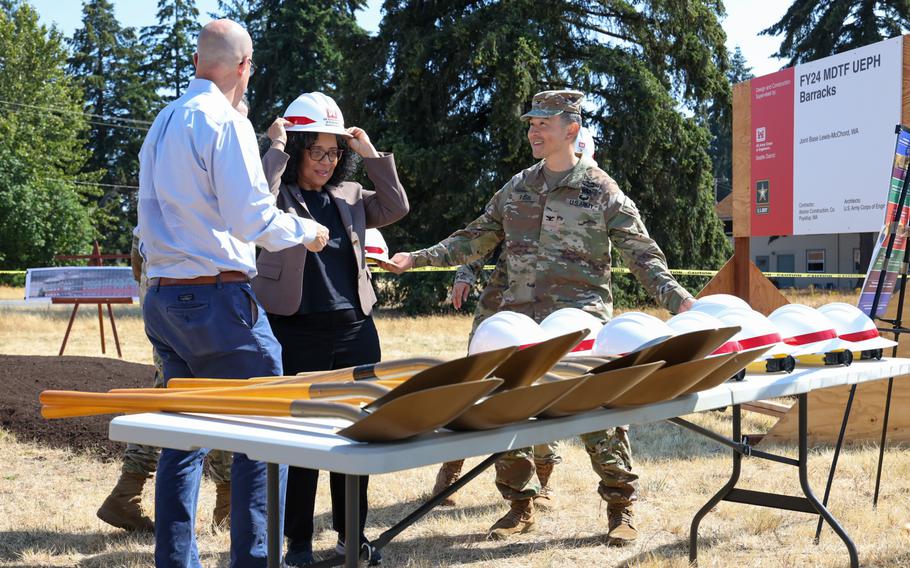
Assistant Army Secretary Paul Farnan, Rep. Marilyn Strickland, D-Wash., and Army Col. Kent Park, Joint Base Lewis-McChord garrison commander, pick out hard hats and shovels for groundbreaking ceremony of a new barracks using sustainable building materials and environmentally friendly construction techniques. The pilot program could be replicated at Army bases around the world. (Derick Fennell/U.S. Army)
JOINT BASE LEWIS-MCCHORD, Wash. — The Army on Wednesday broke ground on a one-of-a-kind barracks at the base that service officials said will be the future home of a relatively new combat unit.
The $100 million barracks will open in 2027 to house 168 soldiers of the 1st Multi-Domain Task Force, the Army said in a statement about its plan.
Lewis-McChord was chosen out of 130 Army installations around the world for the Sustainable Building Material Pilot Program, according to Paul Farnan, principal deputy assistant secretary of the Army for installations, energy and environment.
“We are proving that we can build better, we can save money and increase our resilience and lower our emissions and still deliver the very highest levels of quality for our soldiers,” he said.
Representatives from the Pentagon, White House, Congress and regional Army leaders took part in the ceremonial shovel turning that officially began work on the barracks.
While 21 of the 88 barracks at Washington’s Joint Base Lewis-McChord date from before the 1970s, some of the most modern additions have incorporated college and residential architectural design, such as the Jackson Avenue Barracks designed in 2008. (U.S. Army Corps of Engineers)
It’s designed to use new sustainable building techniques and materials to reduce its carbon impact by 30%.
The 89,000-square-foot, three-story facility features a “twin-barracks” style for unaccompanied soldiers, with two 44,500-square-foot structures. It will have a mix of four-bed, two-bath apartments, and two-bed, one-bath apartments.
The new barracks are also being built to enhance soldier privacy with some single-occupancy rooms, while having communal kitchens and living spaces where soldiers can gather.
“We are certainly building a better future for our soldiers,” said Maj. Gen. Matthew McFarlane, I Corps deputy commander.
Rep. Marilyn Strickland, D-Wash., whose district includes Lewis-McChord, has advocated for more on-base housing and higher housing allowances to offset a shortage of residences for the 45,000 service members at the base.
Strickland said a state statistic showing 7% of residents in the southern Puget Sound area of Seattle-Tacoma are affiliated by job, family or residence with Lewis-McChord.
Strickland said she and Rep. Adam Smith, D-Wash., who represents areas with large military populations on the Kitsap Peninsula, have done a “deep dive” into what soldiers desire in housing accommodations.
“To no surprise of anyone — housing affordability, housing access, spousal employment and child care rose to the top,” she said.
Improvements in living conditions at Lewis-McChord are part of that mix, Strickland said. According to the Army, 21 of the 88 barracks on the base were built prior to 1970.
“Investing in service members is one of the ways we can invest in the challenges we are having with recruitment and retention of those who join the military,” she said. “To take care of those who are serving is showing our patriotism in the best possible way.”
Col. Kathryn Sanborn, commander of the U.S. Army Corps of Engineers for the Seattle district, said part of the work for the pilot project will be measuring the amount of energy saved, alternative materials used and transportation distances covered to see whether the 30% carbon reduction is met.
Success would likely mean the design template could be used for the construction of other future Army barracks. The Army uses a standardized design, then makes alterations based on location.
“You’re not going to have the same building at Fort Moore, Ga., as you are in Fairbanks, Alaska,” Sanborn said.
She said Lewis-McChord is the site for a second pilot project that will use mass timber — super-compressed wood that advocates say has the load-bearing strength of steel — as a main construction element in a new barracks.
With suppliers in Oregon and Montana, the project can take advantage of regional — and likely lower — materials costs that will improve the efficiency of the new building.
Farnan said bids on the initial work have come in under cost projections.
“We can save taxpayer’s money, too,” he said.